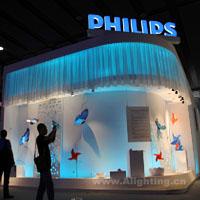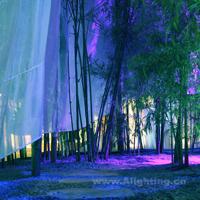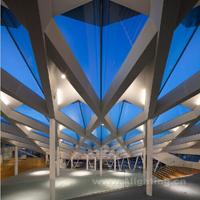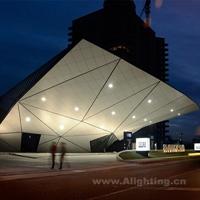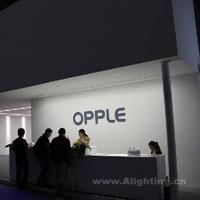
Both Catholicism and the architecture that celebrates it are steeped in history and rich tradition. In recent years, however, the design of Catholic churches has evolved into a more contemporary style, often devoid of ornamentation. Appealing to a more modern aesthetic, the intricate detailing and truly awe-inspiring interiors seem now to be relegated only to historic churches, great cathedrals—or Europe. But this church in Albany, NY, with its 13,000 sq. ft. of new construction and 4,300 sq. ft. of renovated space, resurrects the notion that contemporary architecture can include and moreover, can reflect traditional and period influences. And need not be saturated with light.
"Churches like this are just not constructed around here, especially churches of this size, so it really was a privilege to work on it," said lighting designer Naomi Miller, who was honored this year with a GE Edison Award and an IES Award of Excellence.
The original design intent was to create a Romanesque-style church with a bit of a Gothic open-air feeling, enhanced by stone and wood finishes, that is typically found in grand cathedrals. Arches spring from a series of columns that define the perimeter of the 16-sided worship space. The architect, Jim Hundt, wanted to accentuate both the building architecture, by drawing the eye to the ceiling and consequently, to the cupola in the center overhead, and the liturgical aspects, which are the essence of the space.
LIGHT IN THE DARK
One enters the worship space through the Baptistery, which is symbolic of the parishioner's initial entry into the Kingdom of God. And though congregants pass through this space on the way into church, making it a heavily trafficked area, it was to remain contemplative—a place to sit and meditate. By day, the font, which is situated under a stone canopy, is skylit. By night, midnight-blue-filtered MR16s, located in the canopy, simulate moonlight to create a dramatic effect.
"Father Pat, the pastor, wanted this church to feel dark like those in Europe, which are always dark in spite of their stained-glass windows," said Miller. "The environment was to be created through electric light rather than natural, which is typical of many churches," added Hundt. In fact, the only daylight admitted into Christ the King is through some clear windows in the cupola and the dark stained-glass windows around the perimeter of the space, which are lighted from the exterior using 70W PAR30 metal halide fixtures. All of the windows, including those in the oculus are equipped with electric shades to enable the pastor to create the desired mood, day or night. "It was definitely challenging to make the space feel mystical without making it gloomy—and without making it difficult to see," said Miller.
The Baptistery with its delicate balance between light and dark sets the tone for the entire facility. This grotto-like space, complete with the tranquil sound of running water, is adorned with salvaged bas-relief stone panels imbedded in stucco walls, softly highlighted with recessed MR16 downlights. Sacred oils, which are stored in glass flasks on shelves in the baptismal area, are accented with 7-degree 20W MR16 lamps, giving this space a museum-like quality, which had been suggested by Hundt.
"Father Pat is a collector of church relics," noted Miller. "Over the years, he has watched area churches being demolished—unfortunately, it happens a lot—and has saved some of the beautiful objects, such as fabulous marble sculptures or friezes or altar railings, inside them from also being destroyed. He has preserved their history and purpose by now displaying many of them, primarily the 11 stained-glass windows, in Christ the King." The selection of religious items had been sitting in storage waiting for a new home, and it was incumbent upon the architect to incorporate them into the new structure and to make them look like integrated design elements. "We basically designed the church around the windows," said Hundt. "The artifacts inspired the decision to accommodate both architectural styles—Gothic and Romanesque—in the building."
"The addition of these articles adds a sense of history to the new building and gives it architectural context," said Miller. Added Hundt, "A lot of the parishioners had grown up in these other parishes, so bringing something from the churches of their youth to a current suburban church makes the whole experience even more special."
Sacred Area
As one proceeds into worship space, complex architectural elements interweave to symbolize the crown of Christ and draw the eye upward to the oculus, which brings some natural light during the day to an otherwise dim space. The oculus, being the architectural focal point, continues to glow at night using cost-effective F32T8 striplights.
Lighting layers create different effects for changing liturgical events. Dimmable 3000K 39W compact fluorescent striplights uplight glu-lam arches from column capitals. "The arches were extremely difficult to depict in drawings, so it was difficult to visualize in three dimensions what was going to happen to the lighting," explained Miller. The solution creates dimension and helps to see the arches in silhouette to some extent.
Beam-mounted cylinder downlights provide 25 fc of reading light using 100W PAR38/IR/flood lamps and narrow flood lamps. These are dimmed slightly to extend lamp life and pole-relamped when necessary. To minimize energy and relamping, only the long-life fluorescents are turned on for daily meditation.
PAR38 monopoints are added to graze the converging overhead beams. These use 100W PAR38/IR/NSP10-degree lamps and reveal the texture of the surface by accentuating the ribs of the ceiling. "It brings out the beauty of the structure overhead," said Miller.
Around the perimeter, housed in sloped ceilings, mirror-trim 90-degree MR16s accent column-mounted Stations of the Cross and statuary.
Concealed in the band above the arches, 300W PAR56/NSP luminaires illuminate the ambo and custom-made octagonal altar for reading and light the priest's face. Behind the altar, a floor slot conceals 60W PAR38 IR track heads that uplight banners.
One of the more dramatic lighting elements of the church is a very simple one and one suggested by the pastor: A single recessed 4-degree AR111 spotlight—one of the few recessed fixtures in the space—invisibly shines a narrow shaft of light down onto the altar and illuminates the stream of ascending smoke from burning incense. "This draws your eye, once again, to the top of the church, up to the spectacular architecture and to Heaven in a very mysterious, ethereal manner," said Miller. "It's exceptionally mesmerizing with the banner image of Christ in the background."
Explained Miller, "All lamps on the project are carefully positioned, aimed or louvered to minimize glare, with planned accessibility from a lift or from the roof." At only 1.65 W/sq. ft. connected lighting load, this building uses energy judiciously. An architectural multi-scene preset dimming system allows one-touch scene changes, and according to Miller, "Father Pat loves to 'play' with it. He's a man with a lot of drama in his soul, who really loves his religion, his church and the effects he can create for his congregation."
"We took a very theatrical approach to lighting design because the pastor realized the importance of lighting in terms of creating the focal points that you want to create within the worship experience," said Hundt. "We used it to emphasize a particular area or activity, as well as to emphasize the architecture of the building or a number of things that need to be lighted from the wood ceiling to the various artwork pieces that were placed around the building. I design churches frequently, and this really was a unique opportunity insofar as it allowed us to use lighting to its maximum effect—and I think it was very successful in doing that."
DETAILS
PROJECT Christ the King Roman Catholic Church LOCATION Albany, NY ARCHITECT James Hundt LIGHTING DESIGNER Naomi Miller Lighting Design—Naomi Johnson Miller ELECTRICAL ENGINEER Excel Engineering PHOTOGRAPHER Randall Perry Photography LIGHTING MANUFACTURERS Kurt Versen; Lightolier; Prescolite; Lighting Services Inc.; Forecast; Legion Lighting; Lumiere; Lehigh (controls)
|
|
|
Carefully placed fixtures, concealed within the architecture of this Albany, New York church, shed dramatic light among the darkness.
|


